by B.B. Pelletier
This report is intended to show an easy method of reloading metallic cartridges. The cartridges loaded in this lesson have already been fired with accuracy at 25 yards, so the question of whether or not they’re “good enough” has been answered. They certainly are. I normally use more advanced reloading equipment, however I do not necessarily make more accurate rounds with it. Often, it’s just faster with no other advantage. The beauty of what I’m showing here is that you can reload while watching television, though any distractions that are apt to confuse you are not good. Make sure you’re watching something mindless and that there’s no requirement for conversation.
Reloading is not an art, nor is it a science. It’s a straightforward process not unlike cooking, which, when done right, produces good and repeatable results. It’s safe to the extent that the person doing it is safe. I’ve reloaded for the past 45 years and never have I had an accident during the process. However, I’ve made every mistake in the book; and if you start reloading to the extent that I have, you probably will as well.
Step 1. Making the fired case ready to reload.
In the first step, you need to remove the spent primer from the cartridge. You also need to resize the cartridge that expanded when it was fired. There are several versions of resizing, but I’ll show the most universal one, which is to resize the cartridge along its full length so it’ll function in any firearm of the same caliber.
I normally tumble the deprimed cases until they sparkle like new, but that step is unnecessary. I eliminated it in this lesson.
To decap and full-length resize, we use a full-length resizing die with a decapping pin. I’m installing this die in a Lee Breech Lock Hand Press, which is a modern version of a reloading tool used by sportsmen in the 1880s. It accepts standard reloading dies and doesn’t need to be fastened to a bench. You can hold it in your hands, which means you can load cartridges anywhere. It will decap and full-length resize pistol cartridges with ease. I use a sizer die with a carbide insert so the cases do not need to be lubricated for reloading.
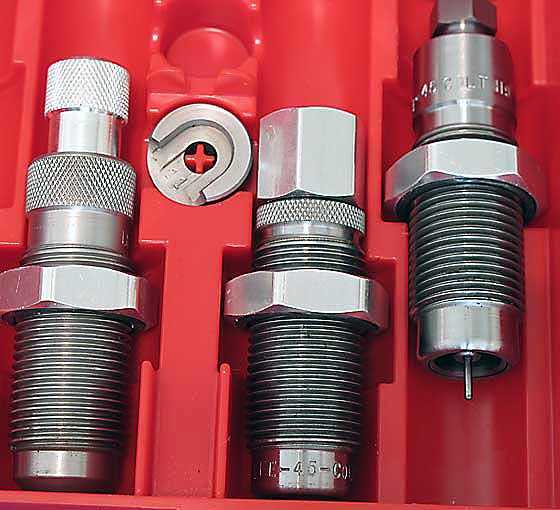
This is a set of reloading dies for the .45 Colt cartridge. The sizer with priming removal pin is on the right, the cartridge mouth bell-forming die is in the center and the bullet seater and crimper is at the left. The small circular piece is a shellholder.
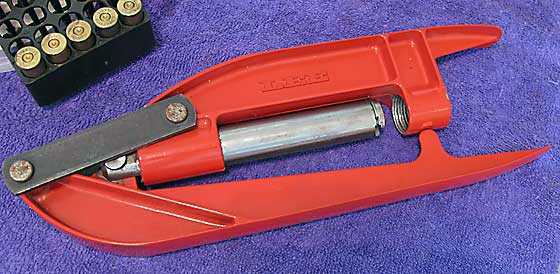
The dies and shellholder attach to this Lee hand press. It’s very inexpensive.
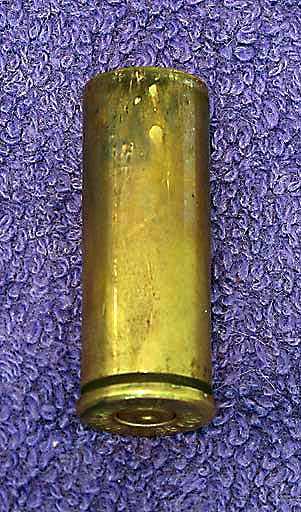
This is a .45 Colt cartridge case that’s been fired. You can see the indent in the primer at the bottom.
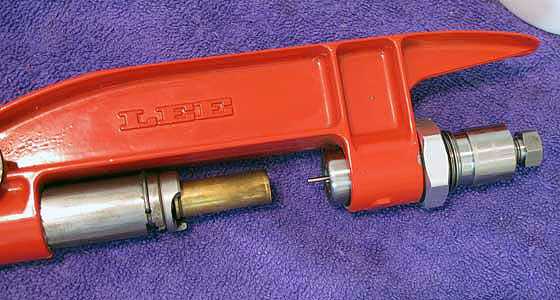
The empty case is inserted in the shellholder and the press handles are squeezed together, resizing the case and decapping at the same time.
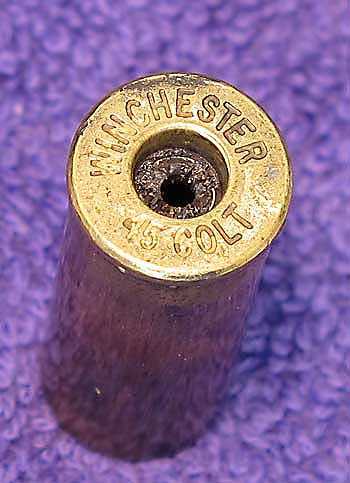
The primer was removed when the cartridge was resized. But that crud in the primer pocket has to go.
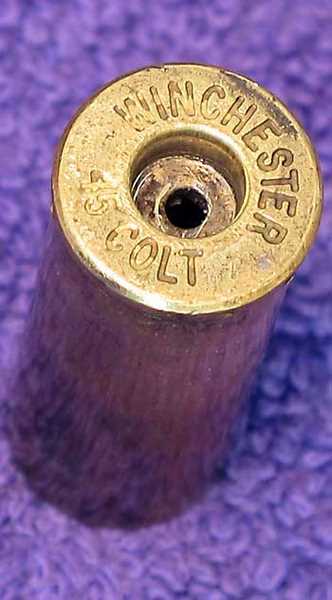
The primer pocket was scraped clean by a small flat-bladed screwdriver. It took 5-10 seconds. This case is ready to accept a new primer.
The reloading components
You need three things to reload cartridges: gunpowder, primers and bullets. I buy primers by the thousand, and Russian primers are now on the market at $19/thousand. That’s less than two cents per cartridge. I buy powder by the pound, and a pound of Unique that I’ll use today costs about $20 regularly, but Cabela’s is selling it for $15 a pound. I’ll use 7.5 grains of powder per cartridge, which will give me 933 reloaded cartridges. At $20 a pound that’s just over 2 cents per cartridge. The bullets I cast myself from lead that’s free. But there’s a cost for the lubricant, so let’s say a bullet costs me a penny. That means I am reloading these cartridges for $5.00 per hundred. The over the counter price is at least $40.00 for the same quantity.
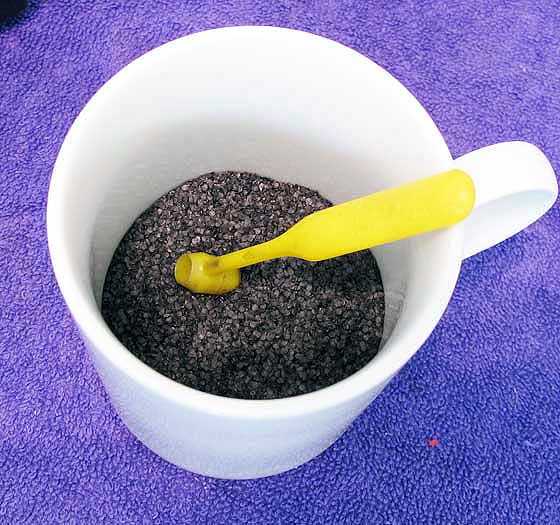
This is the Unique gunpowder I’m using. Two of those yellow dippers filled level with the top equals 7.5 grains of powder, and it won’t vary by so much as a tenth of a grain. This load is so safe that I do not weigh every charge. But I did verify that I’m using the correct dipper every time I reload by checking it on an electronic powder scale.
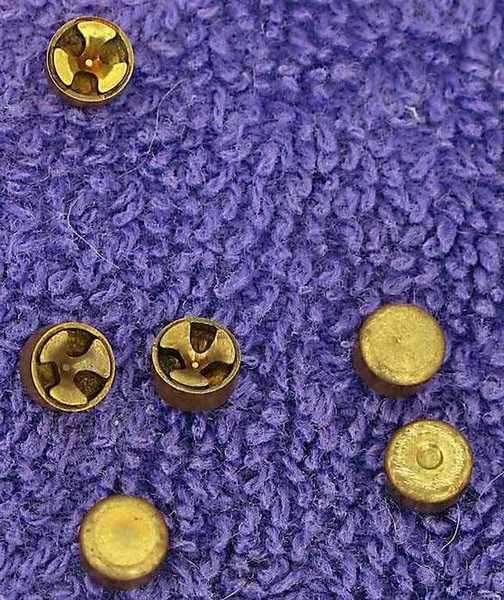
Here are five new primers to go into the cases. At the lower right is the spent primer I just removed.
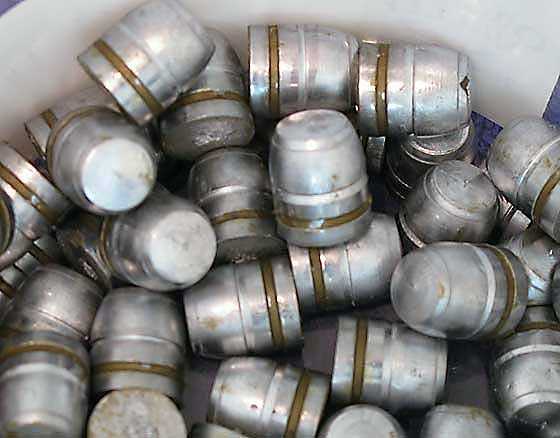
These are 200-grain lead bullets that I cast, sized and lubricated myself. They’re soft lead, so they don’t lead the bore of guns, as long as the velocity is held below about 950 f.p.s., which my load does. In this enlargement, I even see a flawed bullet that got through my inspection. There’s a void in the nose of the bullet at the top right.
Step 2. Prime the case
In this step, a new primer is inserted into the cleaned pocket of each cartridge case. I use a Lee Auto Prime tool that gives me incredible feel over the process. After the case is primed, I run my index finger over the base, feeling for the primer standing proud. If I can’t feel it, the case passes.
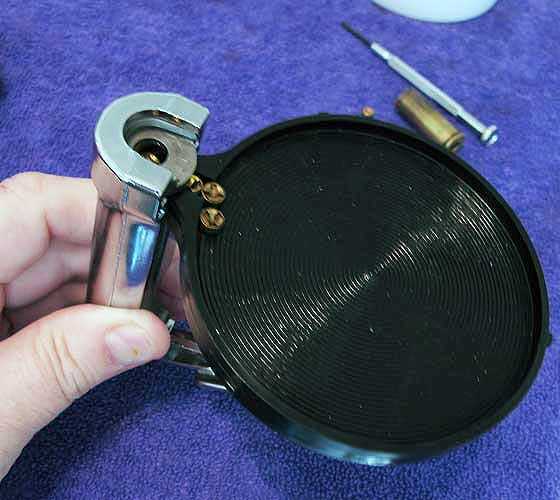
The Lee Auto Prime tool makes priming cartridges fast and accurate.
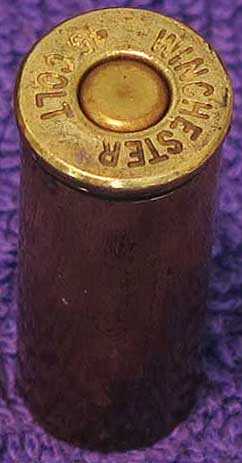
The primer has been inserted and lies below the level of the case base.
Step 3. Bell the case mouth
In this step, the primed case is run into the belling die. A flare is put in the mouth of the cartridge so that when the soft lead bullet is pushed home the brass case doesn’t shave lead from the side of the bullet.
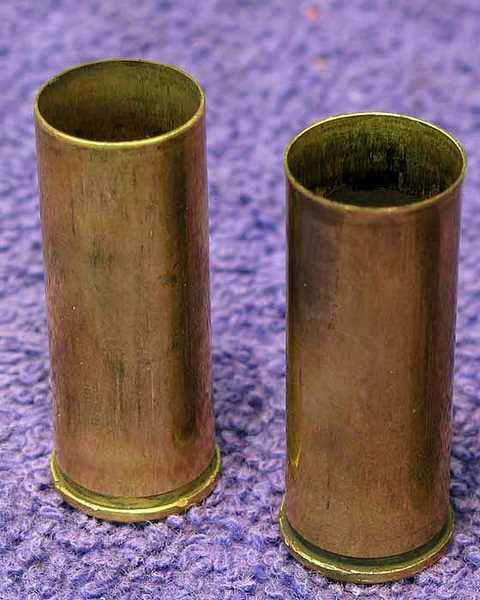
The case on the right has had its mouth flared slightly to accept the lead bullet without shaving lead from the sides. Case on the left hasn’t yet been belled.
Step 4. Put powder in the case
In this step, you put a measured charge of gunpowder into each primed case. I’m shooting a 200-grain lead bullet, so I chose to use 7.5 grains of Unique powder. That makes a very light load that will be safe in all modern guns of this caliber. The bullet will travel just over 900 f.p.s. at the muzzle and will group very well at 25 yards.
I’m using a powder scoop when loading this load. I normally use an adjustable powder measure that’s set to deliver the correct charge, but neither method is more accurate than the other.
Step 5. Load a bullet
In step 5, a bullet is placed in the loaded cartridge case, then the case is run into the bullet seating die that also crimps the case mouth around the bullet.
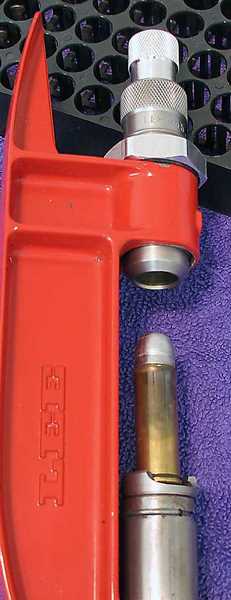
The bullet seating die pushes the bullet into the case to the exact point that the crimp can squeeze the case mouth into the crimp groove on the bullet.
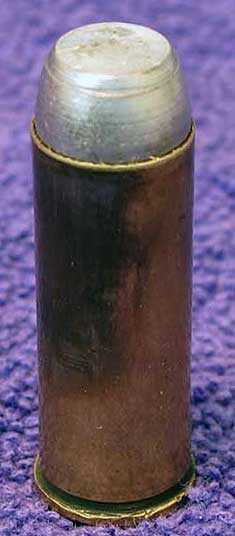
This finished round took about one minute to make.
This has been a quick look at reloading cartridge ammunition. There are many other topics I did not touch on, like case trimming and so on, but this has shown you the basics. For under $100 startup cost, you can be reloading your favorite cartridges just this easily.

B.B.,
Thanks for the article on reloading. It’s nice to see the pics of the process. I’m sure Matt61 will be doing it by this weekend:-)
OH MY, LOOK, LOOK, SEE FRANK, SEE FRANK RUN, SEE FRANK RUN FOR HIS WALLET, SEE WHAT FRANK B JUST BOUGHT ON THE YELLOW..
http://www.network54.com/Forum/79574/message/1287446872/HW55T+Tyrolean+with+heavy+barrel+sleeve
Nice buy Frank, is that your first air gun:-)
Wacky Wayne
It is actually my last….in theory.But then again so was the Liege lock “Amaranth” made by DAQ in ’95.I bought that from Billy Lo.It’s hard to quit spending when such nice stuff keeps popping up.To see that I have made Wayne proud is just a big ol’ bonus! If my understanding of gravity is correct,our collections will try to merge via gravity soon!
Frank,
You’re not spending, you’re “investing”, right :).
man,I sure hope so…
Frank,
Investing for sure! … or so I’ve convinced myself. Although I’ve completely focused new purchases to either field target pistols or rifles. I kept some of the lower power springers, but new buys are for competition or key pieces of FT rifle history… like Billy’s 2005 national championship USFT#6 and the prize that year for a crack at the world 12fpe contest USFT#44. The pair, in my mind are important pieces in Field Target air gun history. And being able to shoot them in contests now, all the more fun.
It’s sad that Billy had to sell some of his collection for the medical expenses, but I’m glad for us, we got a few of the pieces:-).. And he told me he is real glad someone who is competing with them got them.. that me:-) He even spends time giving me help with my shooting skills (via email so far). He’s a wonderful guy!
Anyway, Frank.. keep investing my friend:-)
Wacky Wayne,
Match Director,
Ashland Air Rifle Range
BB,
Nice article. I have a couple of questions though.
First, those pictures are great. How do you get such even lighting with no glare spots?
Second, with regard to that hand press. Are those available today? And how much hand pressure do they require. Could some one with mild arthritis in the hands and wrists use it? Seems it would be a nice tool to occupy the hands while watching TV. You could decap, clean and perhaps even prime and bell tons of cases while watching the Sunday football game.
I wouldn’t want to measure powder or finish seating and crimping while my mind was occupied else where though!
pcp4me: I’m not BB but I can answer your question. The Lee hand press is available today and costs around $25 dollars. You have to buy dies , but it will accept any makers dies that are the common 7/8″ tread size. Natchez shooters supply has the press to name one source. Lee is the Henry Ford of reloading tools and I can reccomend any of his company’s porducts. I have several of his die sets and bullet moulds. The primer seating tool shown in the blog is my personal favorite out of all the primer seating tools I have. Hope this helps ,Robert.
I forgot to add, the press is not hard to use if you have good hand strengthfor handgun case resizing. You might want to consider the Lee starter kit with their least expensive bench mounted press for rifle cartridges that require full length re-sizing though. I have bought a couple of those and they are cheap enough that you can leave them set up full time for frequently shot calibers, Robert.
Robert,
Thanks! I love Lee equipment. Most of what I have is Lee including die sets. Three Lee presses, two Lee auto prime tools, one for large and one for small primers. Any number of sets of Lee dies, some of which I no longer own the guns for them. Several Lee auto disc power measures. Several regular Lee adjustable powder measures. A lee lead melter with bottom pour. Numerous Lee bullet molds, some of which I no longer own the caliber guns they were meant for. And various other Lee accessories like primer pocket cleaners, case trimmers, shell holders and such.
Yeah the guy made a fortune off guys like me mainly because he came up with innovative products that work and cut costs about in half over other reloading equipment manufacturers. Look at the cost differential between his carbide sizing dies and others when his first came out. And his did not leave that awful ring at the bottom of the cartridge that others did!
The man has been a God-send to guys like me who have reloaded tens of thousands of rounds in our lives. I spent a bundle on his equipment and he save me just as large a bundle in the process! And that is NOT counting the savings on tens of thousands of reloaded shells over new off the shelf boxes!
pcp4me,
For the pics, which Mac also complimented me on, by the way, I painted a number of those shots with light. Remember how that’s done?
The hand press is available today from Midway USA.
B.B.
BB,
Never could get the hang of “painting” a subject with light! Just never works for me. Mainly because I do not understand the mechanics of it?
Is it done in a totally dark room with the camera shutter open or what? I read your article about it but just could not get the hang of it!
Frank-congrats 🙂 !
Do change or raise a little bit breech seal ,here is what i have done with breech seal(thanks to Vince)
/blog/2008/4/shimming-a-diana-breech-seal/ (it seems to me a little flat )
Thanks Milan~
BB:
I have been looking forward to this.
Reloading is a practice I have heard of but not seen done.
The issue of how to replace primer caps was a particular mystery to me.
I imagine it could be quite therapeutic reloading ammo.Like when I make my own smokes with a rolling machine. 🙂
Mike:
“under paid,under sexed and under Ike” lol
Not heard that phrase before.
The under sexed bit can be possibly explained by the rough serge uniforms our troops wore.
My Grandad said they didn’t half chaff.lol
DaveUK
This is good. I don’t do much firearm shooting due to lack of convenience. This looks like a way to extend the entertainment value of that plus maybe make it a little cheaper. Might even cause a little more incentive to get out there shoot more.
-CJr
B.B.
Reloading is great but aren’t the shipping costs of primers and powder prohibitive?
Cheers?
Jeff,
The HAZMAT charge of $25 is petty when you buy primers 10,000 at a time. And save $300 per hundred, doing so.
B.B.
PCP4ME,
there is another loading kit for pistols and even rifle brass that only re-sizes the neck of the cartridge, not the full cartridge. This is acceptable if you use the re-loaded brass in the same firearm. No strength required, you use a mallet to seat the primer and the bullet and re-size the shell casing. No, the primer doesn’t get set off by this routine. Here’s a link to the Lee website:
http://www.leeprecision.com/cgi/catalog/browse.cgi?1287496699.5983=/html/catalog/cleeloader.html
From above, you can navigate to the Classic, single stage bench loading kit which I use. Note that Lee is charging retail here and by going to your local store or internet site, you can do better on the pricing.
One word of caution – if you use other than a dipper to pour the powder into your shells, you need to make sure that the tool you’re using, such as a Lee Powder Measure, has dumped the right powder into each shell. I had one instance where I neglected to open the Measure’s feed and after the 4th or 5th shell, was not dumping powder. I caught this by weighing the 10th load, finding it non- existant. I fill 10 rounds, checking the last round’s powder load, before seating a bullet. Nothing worse than having a .38 lodge in the barrel of your new gun!
There’s another tool that’s very handy to have around, a kinetic hammer but I’ll let BB talk about that one 🙂
Fred PRof NJ
Fred,
LOL I already have like 3 or 4 loading presses. One is the Lee anniversary single stage.
Another is a Lee progressive Pro 1000 that was a 3 hole turret and has been converted to a 4 hole turret Lee Classic. That one has the silly squiggly rod in the center which passes through a fragile plastic bushing to rotate the turret. Works great though I do occasionally have to replace the plastic bushings.
The third is a Lee Load-master which is nothing but problematic. Works fine once set up for a caliber but DON’T try to change calibers. That is a major headache.
I also have several of those hammer type single cartridge “complete” reloading sets. Hate em! Gonna sell em all on ebay!
I am only interested in the hand press because it would allow me to sit in front of the TV and deprime and size cases, then clean the primer pockets and prime them using a Lee auto prime.
Even with my turret presses I like to start with sized and primed cases as other wise you can not clean the primer pockets.
For my low volume guns I simply use the single stage press.
This next question is off the reloading topic and open to any one who can answer it.
Where can I get a replacement rear sight for a Sumatra 2500 carbine. I just traded for one and it is great but the rear sight is an unusable peep. Is there some other peep I could purchase and put on it that would be usable? Also does any one make a light weight variable scope with a side parallax I could mount on it?
Thanks for all the help!!
Oops, I mis-interpreted your level of experience and expertise from your question. Sounds like you forgot more about reloading than I know. 🙂
Fred PRoNJ
Great article!
This is an interesting topic for airgunners, to be sure, but well written and admirably brief for such an involved topic. Newbies should know that this is a basic overview of handloading. Following these instructions will produce ammunition of suitable quality for a low powered pistol or revolver cartridge. However, for those of you who are like me, and enjoy fiddling with the details in the neverending quest for handloading perfection, you can occupy the rest of your life in that chase and never run out of new things to try.
For myself, as a safety issue, I try not to handle gunpowder while distracted in any way. Proper measurement is that important. It’s embarrassing to skip a case without charging it with powder, and firing a primer without a charge of powder can force a bullet into the bore without exiting. Firing a live round into a bore obstruction like this is one of the most dangerous accidents that can happen in our sport. As if missing a powder charge weren’t enough motivation to be careful, overcharging a case can be just as bad or worse. I’ve actually been at the range when a gun blew up due to a double charge of powder. I don’t want any part of that, so I focus on the task at hand.
Each set of Lee dies, regardless of caliber, comes with a powder charge table for that caliber that works with the little yellow scoops. Other brands of dies rarely do. You can also get reliable load data on the websites of different manufacturers of gunpowder. Of course, there are also complete books on the subject, many of which I have even found at our local library. I can’t advise strongly enough to stick to the published load data if you want to be safe.
All of that being said, I do find things to do in front of the TV. Mostly wiping the film of grease off the loaded cartridges before organizing them into reusable plastic boxes. Another thing that I do at the very end is to label each box with the loading data that I use. I have used the same 200 grain cast bullet that you show here with muzzle velocities as low as 700fps, and as high as 1100fps, and I want to know for sure which one I’m putting in my revolver, so I use data labels. Let’s face it, once they’re loaded, they all look the same.
Regards,
Jim in KS
In the ’50s, I used a Lyman 310 Tong with Win.243 dies to reload. Used 4350 Powder and an RCBS scale.
Great results, and a relaxing hobby at your desk top. Since I only had two powers, it was not too confusing. But, caution is always number One !
Thanks, Tom.
Pete
One safety/quality check is to use a tray or case block that holds 50-100 cases at a time. Cases with a new primer and powder charge, but NOT a bullet, are placed in the block. By looking at the tray of cases you can easily spot a case with no powder, or worse, a double charge. The bullets can then be seated as normal.
Works fine with straight wall cases, but is not practical when using a progressive press.
Paul in Liberty County
BB,
do you have any knowledge of, or opinion on, these pellets? I’ve been using the pinkish, pointed ones lately, and they’re alright, but its hard to assess score accurately with them.
Malcolm,
No, I haven’t tested these pellets yet.
B.B.
Thanks, B.B. Great information and a stirring testament to the ease of reloading although I believe that I will keep the TV off. First a minor question, visual in nature, that has been troubling me. When you transfer powder between containers like from the storage container to the hand-held scoop or to the powder measure and so on, don’t trace amounts of powder get left behind as a residue at each stage? Doesn’t this mess with the final amount of powder if you’re measuring in grains?
Also, does the hand press method work for high power rifle cartridges like .223 and 30-06?
Finally, not to express defeatist sentiments or anything…. What if a few blown primer pockets cause gas to escape and dimple your bolt face and ruin it? Is it possible to get a new bolt for your gun? I know that bolts have to be matched for particular guns. Or do you have to buy a whole new gun?
Matt61
Matt,
Check out the one that Fred linked to — you can (re)do rifle cartridges for your own rifle, as the entire case will be sized properly by the chamber:). I’ve been around too many whole-hog reloading nuts in my life, and I forgot that there are reasonable approaches. I might have to pick up one for my .30-06 especially, as I’ve been saving the brass, but not shooting it as often as I would like (more fun than you might think) due to cost of even “cheap” ammo.
Matt,
Trust you to find the best argument against something! I have never blown up a gun by reloading, but yesterday I heard the exact case that you described. Some hotshot put a magnum .45/70 round in one of the H&R shotgun receiver rifles and did dimple the primer pocket. Whole gun gone, because it was the receiver that was ruined.
But here’s the deal. I wouldn’t have done that, any more than I would get into a cage fight with some crazed killer. So moderation saves the day yet again. I don’t make reloading mistakes like that because I don’t make mistakes like that.
No residual powder remains during a dump like I make, and more than residual Cheerios remain in your bowl if you clean it with your spoon.
B.B.
Matt,
Yes, this hand method will work on large centerfire calibers as well. I also reloaded .43 Spanish that are twice the size of 30-06.
B.B.
B.B.,
Loading is not something that I’ve given much thought to, but I wonder about a few of things:
1. How many times can a case be used, approximately? I’d imagine that the case would eventually become fragile.
2. What are the cost benefits? Is it, for example, 50% cheaper to reload, versus just buying a new batch of 45 caliber bullets?
3. Using a process, like the one you just outlined, would you end up with something less, more, or about the same, in terms of accuracy? How much extra work would be involved in making a more accurate round?
I think that in order to be willing to put in the extra time, there would have to be a reasonable advantage to doing your own, unless it’s just more interesting or fun.
Thanks,
Victor
Victor,
as I said to PCP4ME and speaking for the Blog, there are a number of people here who forgot more about reloading than I know. That being said, shooting reloaded ammunition is a fraction of the cost of buying new, especially with today’s high pricing brought on by ammo hoarding. I’ve even seen shortages in reloading supplies (primers, bullets). I don’t cast bullets but buy jacketed ammo for whatever I’m reloading. I started due to price. In BB’s case, since he’s casting bullets versus someone like me who buys bullets, it’s maybe 15% of the cost of new ammo.
Accuracy depends on many factors but overall, since a re-loader is extremely careful in powder measurement, bullet type, primer purchase and so on, the re-load will be more accurate than the typical, non-competition box of ammo one would purchase (read lowest priced). I knew one or two fellows who reloaded for accuracy, keeping copious notes of loads, powder used, primers, shells used (and how many times re-sized!) and bullets used. They ate, drank and slept reloading in the name of accuracy.
As for how long a shell casing can be re-used, it can be as high as 20 or as little as 4 times before a case fractures during the re-sizing operation. Typically, when at a range, I’ll pick the casings up that others just leave on the floor. However, some private clubs and commercial ranges won’t let you do that as anything that falls onthe floor becomes their property and they reload the cases and sell to members or customers.
Hope this is helpful and if I made an error somewhere, I’m confident others will chime in with corrections.
Fred PRoNJ,
Hoarding? We don’t call it hoarding in our house. We call it planning for the future 🙂
After the elections 2 years ago, I asked Tom to buy lifetime supplies of reloading components for .45 Colt and several other important calibers. Plus, we acquired a number of additional firearms (and are still looking for some items). In addition to food & water, guns, ammo & reloading components are eminently useful and tradable goods should there be a need for survival in a barter-based society.
My parents ended up living in such a situation for many years while stranded on mainland China after the end of WW2 while Chinese communists, Chinese nationalists, the U.S., White Russians and the Japanese fought over the future of the country.
Edith
A very good point, Edith. But I still get annoyed when I can’t find bullets to load in my .380 auto casings (9mm Kurz or short).
Fred PRoNJ
PS – is BB allowed cheeseburgers?
Fred,
BB needs to stay clear of dairy because he’s lactose-intolerant. However, he does like really good burgers. Red Robin used to be his favorite, but now Smashburger is No. 1. They just opened up a new place not far from our home. The burgers are the best we’ve ever eaten.
Edith
Edith,
I hope you realized I’m still teasing you by suggesting I’m going to get BB to eat “unhealthy”. However, if he and Mac aren’t attending any type of group dinner Friday night, I’ll be glad to invite the two of them to have dinner with Tom the SEAL and myself. There’s a very nice BBQ restaurant (non-chain, thank God) about 2 miles from the Civic Center. I’ll pay!!!!!
Anyone else who is attending the show is welcome to come along but I’m not paying for you 🙂
Fred PRoNJ
Fred,
Tom told me about your friend the SEAL & that he spotted an “interesting” character at last year’s show.
Edith
Fred,
I have a friend who held numerous world records, and won or medalled in pretty much every world class title, including several Olympics. He was so active in the sport of shooting that he eventually said that he didn’t have time to do his own reloads. At first this left me with the impression that reloading takes too much time, but then I realized that he really was too busy either practicing, or coaching in youth programs. He’s a super great guy, and to this day travels the world with American shooters, and in particular junior world class shooters. I think that when he did reload, he got better accuracy than store bought ammo. On the other hand, being a top rank American shooter, who seems to know anyone who is anyone, he also had great resources for everything.
Fred,
If accuracy of reloads is not better than factory ammo the reloader is doing SOMETHING wrong! Or just not trying for accuracy.
I spent most of my years as a youth and adult shooting numerous types of competition and my ammo was reloaded for the maximum accuracy possible to increase my chances of success. I even went a far as loading bullets for the amount of jump till the bullet engaged the lands of the gun. Usually I loaded them just barely touching the lands as most often that was the most accurate.
But in some cases they were more accurate with .001 – .004″ “free bore” before they touched the lands.
In fact much more attention was given to producing the maximum accuracy ammo than to the gun.
Before I became disabled I was a great shot and very cocky and arrogant. So I delighted in taking guns every one said were “clunkers” into a match and beating the pants off their $2000 – $4000 gunsmith tuned match guns!
My revolver of choice was a Dan Wesson stainless model 15V with 4″ barrel. My semi automatic of choice was an AMT Hardballer .45 ACP in standard configuration. Both guns were highly gunsmithed by myself. Both from a ransom rest could print groups none of us could shoot off hand!
It was SOOOOO much fun uncasing these guns and watching the “hotshots” guffaw and hoot and smirk and look at me and treat my like a noob who had no sense and didn’t know what I was doing. Didn’t take long for the grins and smirks to vanish and the head scratching begin.
After all how could a stupid noob like this come in here with such a crud gun and beat us with our $2000 – $4000 “race guns”? SOOO much fun!!
PCP4ME,
I forgot that how deep you seated the bullet was a major contributor to accuracy of the round (is head spacing the right term here?). I never got into competition as I discovered early on with my HIgh Standard Military Victor that I was a middling shot and wouldn’t really be competitive with the guys in that particular league (East Orange, NJ). You are very fortunate to have been blessed with the eyesight and muscle coordination to be a top competitor.
Call yourself “challenged” instead of “disabled”. It’s a challenge to do what you used to do is how to look at it but you can probably still outshoot me!
Fred PRoNJ
Fred,
I like your outlook. And it would indeed be a challenge to out shoot you or any fairly good shot these days.
This is why I got into air guns. I can no longer handle the recoil of most cartridge guns. Exception is of course low recoil rimfires and light pistol and rifle loads. If the guns themselves are light enough for me to hold them that is. Which is why I am in the market for a 30 carbine or a kel tec 5.56 shortly.
But first I now have a 3000 psi pellet rifle and discover it was a mistake from minute one to buy a 3000 psi scuba tank to fill it. So now am scrimping, saving, and looking for a “real good cheap” 4500 psi carbon fiber tank!
Fred,
I don’t know that I can eat ribs yet. Too fatty, I think. But let’s talk at the show.
Tom
Victor –
The part of your comment that I like the best is “unless it’s just more interesting or fun”. For me, it is. I get so much satisfaction from tinkering with the handloading process, that I sometimes tell my friends that I don’t know if I reload so I can keep shooting, or shoot so I can keep reloading. 😉
I have been reloading for about 40 years now, and at this point, I use my own cast bullets almost exclusively. When much care is applied to the production of cast bullets, they are very accurate… close enough to the accuracy of jacketed bullets in my rifles to be worthwhile. My K-31 Schmidt-Rubin carbine, for instance, will shoot ten shot groups at 100 yards of about two inches with the issue sights. I can’t do any better than than with the expensive Swiss military ball ammo. Another positive aspect of using cast bullets is that, since they are loaded to lower operating pressures than jacketed bullets, the cases do last a lot longer. I can’t help but think that it’s easier on my old guns, too. (Not to mention my old shoulder!)
Regards,
Jim in KS
Jim,
Knowing the kinds of personalities that serious shooters have, it’s fairly obvious to me that reloading would be fun, and at a minimum, very interesting. For some, it might be purely practical, but I can’t imagine that they do it only because it is practical.
Practical is in the mind of the shooter. One might define practical as, “It is important to be self-sufficient and knowledgeable”, while another might way, “I’d rather have more time to shoot”, and yet another might say, “I can do a better job”. In each case, it’s all about the LOVE for shooting.
Victor, I can answer some of this based on the Lyman reloading manual.
1. Case life depends on the pressures that you load it too. The manual says between 4 and 8 times. Fred, for what it’s worth the manual is very adamant against picking up other people’s cases from the range since you can’t know how many times they’ve been fired.
3. Tables exist of loads for accomplishing various things with cartridges. In the Lyman manual, the potentially most accurate load is set in bold! I believe that you start with this and experiment with the recommended powder charge to customize a load for your gun, and then you should have something better than the best factory ammo.
Matt61
Matt,
I figured that someone would have some kind of table with practical guidelines. It only makes sense that most of reloading is science, and that becoming an “artist” takes a lot more time. Good to know!
But they look so shiny and lonely just lying there on the concrete…….
Fred PRoNJ
I wonder if the problem with old cases cracking isn’t simply work-hardening. If it is, annealing the cases before sizing (heat to red and let cool in air) should soften them up and extend their life by quite a bit. Just a random thought.
BG,
BG,
Bingo. You are on the right track there. But another factor in case failure is pressure. The hotter your loads the more pressure and deformation you get. That causes more working in resizing. Annealing will help but bottom line is the more pressure the less case life no matter what.
BG_Farmer,
I anneal some case mouths. Like .43 Spanish, for instance. Because those cases cost $57 for 20 new empties!
But .45 Colt lasts so long that I don’t bother annealing them. And .45 ACP lasts even longer. So long, in fact, that the headstamps get mushed out of existence.
B.B.
THANK YOU ALL FOR YOUR WONDERFUL RESPONSES!!!
Victor
Victor,
Some cases like .45 ACP can be reloaded as many as 20 times. Others like high-velocity rifle cartridges or thin cases like .22 Hornet have limited times to be reloaded, maybe 5 or 6. The savings is more like 90 percent when you make everything like I do. But better than that, I can make a cartridge do exactly what I need it to, which you cannot often buy.
As for the time required, it’s not a definable thing. I can crank out 300 .45 ACP rounds and hour, but it takes me an hour to load 20 cartridges the way I have outlined here.
Fun and interest are the definite attractions. I can make a .22 Hornet behave like a .22 long rifle if I want to.
B.B.
BB,
Great blog. I wasn’t excited about it, because I thought you would go overboard with the equipment, but it does look practical. Try to stay out of trouble and take care of yourself on the road trip.
Toby T., scientific studies have proven that those living at higher altitudes have larger chests.
Wayne, don’t bet money yet on my reloading. Ease of reloading is a state of mind that is very relative as shown by Star Trek. There’s a particular episode where Dr. McCoy consents to receive alien knowledge in order to surgically reattach Spock’s brain which has been removed from his body. Taking the role of Dr. McCoy, I would be standing under a dome filled with alien knowledge–it could just as well be the Lyman 49th edition reloading manual. When the switch is thrown, I collapse on the ground in a cry of agony. But then I raise my head with a beatific expression and say, “It’s so easy a child could do it. (In a deeper register and with conviction) A child could do it!”
Next scene, I am working furiously at the reloading bench among the primers, dies, presses, case trimmers, powder measures, straight line bullet seaters, rimmed cases, semi-rimmed cases, belted cases, straight cases, semi-tapered cases, and lubes and Mr. Scott says in an aside, “Captain, he’s working at warp speed.” But then I start to hesitate and bite my lip in confusion. Finally, in a fair imitation of Dr. McCoy, I rear up with a crazed expression and in a raw voice cry out, “Nobody can surgically connect a living brain (reload cartridges)!”
Then Kirk steps forward with command authority and says, “You could! A minute ago, it was child’s play for you.” Cowed, I go back to the reloading bench.
Captain’s log supplemental: Matt has resumed reloading but he is faltering, uncertain. I’ve instructed him to give the highest priority to communicating with B.B. and the PA blog in hopes that they can guide him….
Matt61
Edith,now that BB is safely on the road….I have a question.My right arm is a little larger because I use it more.Which hand do you smack Tom with? 🙂
Frank B,
I’m ambidextrous 🙂
Edith
You are the PERFECT woman,Edith!
Frankb,
You forgot to include the consummate Lady!
Bruce
She’s the bees knees!
nice article. I have a question regarding lead free pellets. I ahve recently been shooting HN lead free barracudas in the garage as we have 3 kids whom I do not want to expose to lead. The issue is that I cannot find anything regarding the composition of the lead free pellets. I would like to know a little about their makeup so I will know any risks. in addition, can they damage barrels sice they are more firm than lead? Thanks!!
Will,
I will look into this but I expect the formulae for pellet alloys are all proprietary. On the other hand, I’d be very surprised if anyone substitutes one toxic material for another. Shotgun ammo makers didn’t do it and expect pellet makers won’t either.
B.B.
Will & BB,
My trade for 30 years of my life was a chemical technician. I tested all types of chemicals from metals to acids and alkalies to pharmaceuticals to drugs to you name it! So I have an extensive background into chemicals and their properties.
Actually ALL metals used in the “lead free” alloys are toxic if ingested or the airborne dust breathed. But they are deemed by manufacturers to be “less toxic” than lead.
Typical metals used in these alloys include aluminum, tin, copper, zinc, bismuth, antimony and possibly cadmium and steel. All when breathed as airborne dust are extremely toxic. However most don’t splatter into dust like lead ammo does when it hits steel. Therefore less dust to breathe means less toxic!
Even something like plain old iron if ground into a very fine powder and dispersed into the air and breathed in the right amounts would be toxic. Just takes a LOT of doing to get iron into dust form and a lot of breathing it to build up toxic levels.
But did you ever notice that these “lead free” pellets when fired into ballistic putty are not even deformed? Even with a “magnum” gun? But a lead pellet is completely smashed flat and you can SEE the lead dust smear on the ballistic putty if you carefully pull it away from the pellet.
That helps. I also noticed that hn puts a warning that their lead free barracudas contain lead? This is on the tape sticker around the tin of pellets. Are there any other good lead free ones to try? Do they damage barrels because they are harder?
Thanks!
Will,
That “contains lead”sticker is probably a lack of configuration control. Someone at H&N is asleep at the wheel.
No, non-lead pellets do not wear the barrels of steel-barreled airguns. But sometimes the plastic ones will gunk up the bore.
B.B.
Thanks for all the help! I jsut bought some more of the HN lead free as they group as well or better than the lead ones in my spring gun.
Will,
I will be testing those lead-free pellets against the best lead match pellets soon.
B.B.
Thanks edith…now I’m hungry for a hamburger.
I hope Tom is doing fine and that he has fun in Roanoke.
Hammer type reloaders…..wow I seen an old timer use on when I was a kid. I thought he was crazy, but they do work if you are on a tight budget. I’ve used a hand held lee loader, similar to the one in the article, and a hand press at a Friends house about 20 years ago. If you like to shoot a lot, I would recommend Lee Loader for sure. As fore me, I’m sticking to rim fire for now.
Re loaders every where AND non re loaders,
BUY Lee reloading equipment. NO I DO NOT have stock in the company nor do they pay me for commercials. My enthusiasm comes from many decades of using their products and saving a ton of money doing it!
Are they the best for everything? NO! Case in point….their Load-Master press is a great inexpensive production press for high volume reloading IN ONE CALIBER ONLY! So let’s say you shoot thousands of .45 acp cartridges per month. Then buy one set up already for .45 acp and use it exclusively for that caliber.
While theoretically you can change from caliber to caliber, in actual practice it is a BIG pain. Getting everything adjusted for the new caliber can take many many hours! In one case I could not get it adjusted and had to ship it back to Lee! So it will crank out 400 – 600 round per hour of your favorite caliber, but get another one if you need to load two calibers in volume!
If you load only a moderate amount of a caliber and don’t need 500 rph (rounds per hour) average, then consider the Lee Classic kit. At about $135 with tax plus a set of dies you get everything to load another caliber at about 100 – 250 rph!
If you occasionally shoot 25 to 100 rounds of ammo in a caliber a hand press at about $30 per plus a set of dies or a single stage kit at about $40 plus a set of dies will do you at maybe 50 – 100 rph!
And if you have a ready supply of lead or lead alloys then their bullet casting equipment and their aluminum molds simply cannot be beat!!! Single cavity molds produce maybe 100 bullets per hour with double cavity going to around 250 per hour and 6 cavity at maybe 750 – 900 bullets per hour. Of course you have to lube them and Lee equipment makes that easy and painless. If you use tumble lube molds and their tumble lube, no sizing is needed and the process is quick and painless!!!
PS: Would someone email Lee and tell them to send me a commission check? LOL!